From the Shipkeeper
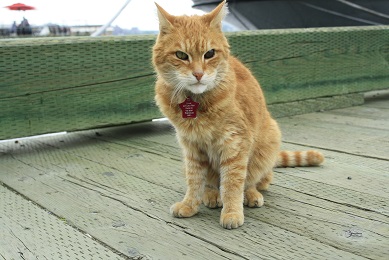
Erik the Red has passed away. The ginger striped tabby cat was a former RCO (Rodent Control Officer) aboard our exhibit Ship CSS Acadia at the Maritime Museum of the Atlantic and was our ever-diligent crew mate, colleague and a beloved friend to all who knew him. Erik left us at roughly 3:15 pm on Tuesday, August 1st and passed on in the loving company of friends and adopted family, myself included. Erik was somewhere between 20 and 22 years of age.
I count myself among those very lucky folks who have been a part of Erik’s "family". As Ship-Keeper aboard Acadia, I had the honour and privilege of serving with Erik in a professional capacity; but, more importantly, as his primary caregiver, I guess you could say I was Erik's erstwhile dad. It’s been said that people cannot own cats, and that the reverse is a more accurate description of the feline / human relationship. The rub of truth in that statement was never more appropriately applied than in Erik's case. For, you see, Erik chose us - quite literally.
Erik came into my own life as a stray in 1998 after following me and a friend the length of Gottingen Street from downtown to the north end Hydrostone housing area. The poor, woeful, skinny little dude looked the epitome of 'hard-scrabble' but with intensely kind eyes and a look (at least, I certainly thought) of intellect and utter discernment. My friend Danielle and I did not even need to discuss for an instant the fact that this little kitten would not be returning to street life. Danielle took the tiny lad in to her house that night, but would not be able to keep with him. She and Sean, her sweetie at the time, and also my friend who volunteered aboard Acadia, were due to leave within days for parts west in Canada.
Meanwhile, aboard our Museum Ship, a potentially bad situation that had been stewing for a couple years was getting out of hand. Rodent Control Officer Clara, an absolutely gorgeous example of the Calico breed of cat who had joined the ship in September of 1996, had simply not turned out to be a particularly efficient RCO. Clara had come to us via the Bide-A-While animal shelter in Dartmouth in order to fill the RCO position left vacant on July 26, 1996 when her predecessor, Bertram Q Bilgewater (or, just "Bert") passed away unexpectedly.
Bert had been the quintessential RCO; fearless and unrelenting in his duty, both aboard ship and on, under or around the surrounding wharves and jetties. Clara, for reasons we never quite determined, just couldn't get the knack for it. At best, she might snag a mouse or small rat from the wharves and bring it aboard ship where, before actually dispensing the poor cowerin' beastie, she would lose interest and allow it to stroll on its merry way. By autumn of '98, we were beginning to find, left behind by the wee ones, evidence that we had a ‘growing’ problem.
And so it was decided, in autumn of '98, between me, my friends Sean and Danielle, another friend and then co-worker Thom Adams, and my then senior colleague aboard Acadia, Fred Cox, that we would try the new young tabby foundling in an apprentice roll aboard ship - and that his name would be Erik the Red. I fashioned a makeshift collar and tag writing down Erik's name, title (Junior RCO), the Museum address and my cell phone number. And that, friends, is where the aforementioned line "he chose us" truly finds its veracity. Because Erik did not take to the ship, at first.
There is an undeniable safety consideration to keeping four-legged crew aboard a ship: they must be provided their own reliable and unrestricted access and egress paths to get above or below decks. Aboard Acadia, this was accomplished by leaving a port-light lens open in a sequestered area on the main Shelter-Deck which led to the galley below. As had been our previous custom, Erik was shown this 'door' to below decks when he was first brought aboard. He was next introduced to Clara who, admittedly, did not seem overly impressed by this almost cocky youngster inhabiting HER space but also seemed willing to observe diplomacy.
Erik was then fed and watered, shown the litter box and given a general below decks tour after which, with all the assuredness of an Admiral conducting a fleet inspection, he selected the OIC's crib berth, jumped up onto the bedding, pawed at it and circled twice before having a lie down. "Mission accomplished"; I recall thinking, believing we had saved a street cat from a hard-bitten life of homelessness.
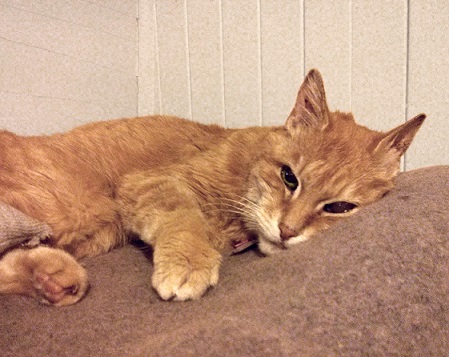
Relaxing in a bunk – photo: Steve Read
It was three hours later, as skies were dusking to twilight, that I was sitting in the Officer’s Mess and saw Erik dart past the door toward the galley. I heard a jump 'bump' and knew he was gone. Rushing above decks and to the gangway, I could see no sign of him. I searched the wharves for a couple hours working my way toward Pier 21, then back past the Museum to Purdy’s Wharf, then back to Acadia - all the while with the sick feeling of failure in my throat, and all to no avail.
The next day, around the time I heard the noon gun from Citadel Hill, I received a call on my cell phone. The caller wanted to know if I was missing a cat. I gratefully replied that, yes, we were indeed missing a cat as the voice on the other end described Erik to a tee. "Where in Halifax are you located?" I asked. As I ascended the companionway stairs, making my way above, I could only smile while the voice on the phone said; "I'm down on the wharves right by the Maritime Museum of the Atlantic, I'm near a big white ship". I approached the gangway brow and looked down toward the jetty to see my caller gently stroking a much welcome sight. Joining them on the jetty, I gave Erik a chin scratch, but he was having none of that extra coddling. He leapt to the gangway, then trotted up and over to his secret door to get below decks.
Now, I wouldn't want to leave the impression that Erik's choice of home (and of us as company) was completely clear at that point. It took almost a full month for him and Clara to finalize the terms and conditions of their détente, which became clear by observing their interactions through that period, and would extend to the length of time they served together. On board, Clara was queen and Erik deferred to her - and never even particularly begrudgingly. Down on the wharves and jetties, however, it would be a different matter. Down on the ground, Erik was king and master of all he surveyed and he would have no truck with Clara bossing him around on his turf. A tiny claw size breach at the tip of her left ear, incurred that November, would be a reminder of this fact that Clara carried to the end of her days.
Moreover, when Erik did choose us, and from that time ever after, it was clear he chose Acadia only as a base of operations. Aboard the ship there was food, drink, shelter, a generous living space to explore and the refuge of dozens of comfortable bunks to choose from in order to rest one's head, paws and tail. But home was everywhere. For, Erik was a rover - always was and always would be. Clearly, you can take the cat off the street, but getting that street out of the cat is a thing entirely different.
More the better, that aspect of his character. Ultimately, it was that spirit - his character - that allowed Erik to assume the absolute best of both worlds. He enjoyed a secure berth and base from which he could come and go at will, while claiming the entire waterfront as his personal domain. And what a domain! Bustling with people in the day, never quite shutting down entirely nights, and filled mornings or evenings with a steady stream of commuters who would come to enjoy, cherish and even expect Erik's daily greetings, the waterfront offered more head strokes, chin scratches, treats and more abject love and adoration than most felines could likely fathom. The Irish have a saying for a person who leads a charmed life; "the life of Reilly" they say. Well, in my own humble opinion, I believe that Reilly fellow must have lived the life of Erik.
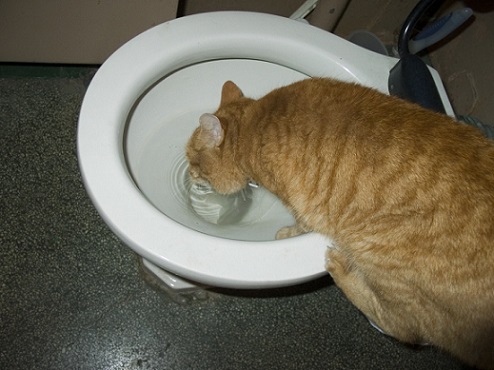
A refreshing drink? – photo: Fred Cox
The two weeks following Erik's joining Acadia were active. As with Clara before him, Erik was entrusted to the unrivaled care provided by the staff of the Fairview Animal Hospital for inspection, detection and some injections. The street life had, in fact, left our wee lad quite malnourished - which made age determination difficult. It was clear to Erik's doctor that he was at least six months old, but he estimated his age could be as much as two. My off work hours over this period were filled with calls to veterinarians and animal shelters, posting notices to newspaper classified sections, as well as printing and posting "Are You Missing This Cat" flyers on telephone poles and message boards in public offices, schools, community centres and accessible apartment building lobbies. Not a soul reported back.
However, half way through the first two weeks, Erik went missing again overnight. This time, he did not show up wharf-side the following day. On the afternoon of his second day away, I received a call from a residence on Barrington Street. They had picked Erik up by the waterfront the previous day thinking he was a stray, but had initially overlooked his written collar tag with my phone number. Once I had retrieved the lad and set him loose again down on the Museum wharves, I then called on John Larkin, a local engraver at Barrington Place's Keyosk, to make up a proper collar tag. On one side was etched name, address and phone; while, on the reverse, John inscribed; "I live on the Ship ACADIA at the Maritime Museum. I know my way home. Please put me down".
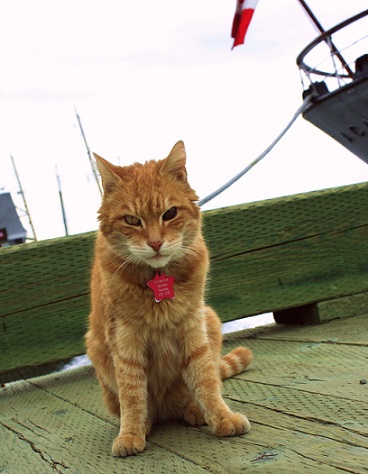
Please read the tag! – photo: Gerry Lunn
By the way, Erik did take care of that aforementioned ship-board rodent problem. And, I do mean in a hurry. We'll never quite know how quickly or efficiently he did so but, it was about three weeks into his tenure aboard that I recall mentioning to Fred Cox that I had not seen any critters or new signs of their leavings in a little while. Neither had Fred.
Erik's career service record was inspired and unblemished. Certainly, it became standard duty, prior to opening Acadia for daily tours, to inspect all nook and cranny of public quarter for carrion of rodent or the occasional seabird. RCO Clara's earnest but mishandled attempts to aid in clearing the wharves by victualling the ship would exacerbate the challenge somewhat for the duration of her service aboard. And Erik would learn to perform his duties with a yeoman's efficiency. An agile, natural athlete and rarified salt, fully possessed of his sea legs from the beginning, Erik would make his way from scantling to fiddley grate to bilge, deck to deck, stem to stern with a diligence un-rivalled. His career legacy is one of service to ship and company that was, quite simply, flawless.
The ensuing years of Erik's time with us saw his public popularity go from burgeoning to full blossom; all to absolutely no one's surprise. A constant fixture on the waterfront and beyond for years, Erik was likely the most photographed and 'shared' cat in Halifax (for an hour or so on the afternoon of his retirement party in 2015, Erik was the biggest trending CBC on-line story in Canada). I'll offer a twofold explanation for this ascendance to celebrity. Firstly, Erik was an incredibly attractive fellow - sleek, quick and powerful (I once saw him wrestle some food scraps from a ferret), with incredibly kind and intelligent eyes and a chiseling to his facial features. Secondly, he was ever and always approachable - at least, on first meeting.
Now, to that first statement about Erik's physical aesthetics, I have already offered the full disclosure of being his dad, though the opinion is shared by all I've spoken to who knew him. As to the second statement, certainly; "..at least, on first meeting" serves as it's operative segment. I would be mistaken to infer Erik was a sailor of the ilk to hold with "any port in a storm". For Erik would approach anyone at any time with a rarefied demeanor that was at once both demure and assertive. But he was always his own man and never displayed the slightest doubt in his ultimate superiority over the silly humans that fawned over him. Erik could leap up beside you on a wharf-side bench bold as brass - heck, he could leap right onto your lap - and flash you his "come hither" look; but two or three head or chin scratches later, had you not provided something to nibble on, he'd be gone in a whisper seeking rations from someone else.
While I saw this strategy employed many, many times, my favorite memory of it occurred one sunny June lunch hour in 2001. I was working my way through a sandwich while sitting on the wharf cap rail next to Acadia's gangway. Across the jetty on the opposite cap rail sat three couples spaced about eight to ten feet apart. I watched as Erik descended the gangway, crossed the jetty and leapt up onto the cap rail beside the first couple. A few strokes to his head he willingly obliged but with no treats forthcoming he moved on to the next couple where the same ritual played out to none of Erik's personal avail.
When he got to the third couple he was finally greeted with a chin scratch AND a treat. He stayed for a total of four treats, each administered between copious petting of his sides, face and chin but was gone before the fifth. Erik crossed the jetty back to the ship amid calls of "here kitty, here kitty, c'mon back" and started up the gangway stopping fully mid-way, to cast me a sideways glance, before continuing on up. Although I will never know with absolute certainty what that sideways glance signified, I will go to my own grave firm in my belief that Erik was simply saying "See that Steve? That's how it's done: Always leave them wanting more".
There is, of course, one other facet of Erik's character that is at least partially responsible for the renown he attained. He was, at heart, a bit of a pirate - or, to be more precise, your favorite cartoon version of a pirate. Over the years I've seen Erik employ tremendous stealth as a one man, late night boarding party to neighboring or visiting vessels with a good rate of success (Bluenose II, whenever visiting, was a favoured target). I've seen Erik pull pigeon from a ferret, and I've seen Erik, running ahead of a shouting stranger, chased the length of the Museum wharves with a leg of chicken in his teeth.
Michael Wamboldt, one of my predecessors aboard Acadia, would attest RCO Bert was just so canny but Clara, not so much. After a couple of years around Clara we had grown un-accustomed to this level of chicanery. My own illusions were put to rest one night shortly after Erik joined the ship. I had just settled onto one of the leather bench seats in the Officer's Mess about to start in on a substantial size fillet of pan fried haddock. I was two or three bites into it when I heard the sound of an intruder on deck and headed above to shoo them off. Of course, when I returned to my plate, there was nary a trace of fillet.
Now, as any mariner with the slightest notion of maritime and nautical history will tell you, the theft of food aboard ship is an offence of the highest degree. As seventeenth century English Naval Administrator and Member of Parliament Samuel Pepys once observed; mariners could endure hard work and ragged clothing, but, "any abatement from them in the quantity or the agreeableness of the victuals," could turn sailors against service. As a consequence, all ship-board provisions were kept under lock and key, accessible only by the cook, chief steward and, possibly - but not always - commanding officers. My pique at Erik's fish filchery was, however, short lived. Donning my clothes the next morning, I found, nestled in my inner, left boot heel, the head and rump of a recently disposed rodent. Erik had left me prime cuts - the choicest bits - and I figured it was just his way of saying thanks.
Erik's time at the Museum had a rhythm to it much like the roll of the seas; in turn, fair to stormy to becalmed. Mostly calm to fair, but turning a tad stormy whenever he'd give our hearts a murmur by failing to return to Acadia for his evening grub. The simple fact is, Erik was always too cute for his own good. On four separate occasions, he has been mistakenly rescued (or cat-napped outright) to be AWOL for stretches of six to ten days. Those incidences are beyond the singular over-night occasions, of which there are too many to log.
And all of that, and perhaps an event or two I may have overlooked, pales numerically to the daily (and nightly), consistent volume of phone calls to my mobile - usually beginning with some variant of "Uh, we found a cat down on the waterfront with your phone number…" and, more often than not, ending mid-sentence with a chuckle as the caller flips Erik's tag to read the bit about "…I know my way home. Please put me down".
In time, the length and breadth of Erik's domain diminished. Once extending from the National Defense dock-yards to the north, to Point Pleasant Park southward, and to the Citadel and Commons west, his stomping grounds, by the fourth year of his tenure, comprised mainly the extent of timber planked board-walk along the urban waterfront. Thus it would remain until Clara's official retirement from the senior RCO position in 2010, at least, during the day.
No amount of time, or the physical constrictions it may convey upon the body, would ever deter the unpredictability, and often comical results, of Erik's nocturnal surveys. There were thirteen cumulative years of profuse, diverse forays no better illustrated than with a phone call received one summer night in 2007 during the hours of the fore dawn dog watch. The caller was a door attendant at an Argyle Street drinking establishment. Apparently, Erik was working the outdoor line of waiting patrons with all of his skill and cunning - beguiling, coaxing and entertaining the lassies in particular, all the while conniving his share of assorted street vendor snacks.
To be fair, not all of Erik's shore-side sorties ended without so much as a gripe. One sub-zero December morning in 2007, while I was visiting family out of town, Museum Boat-Builder Eamonn Doorly was pressed to launch boats with double haste in order to retrieve our junior RCO from the frigid drink. One witness reported seeing Erik lose his footing on the icy wharf timbers while investigating an area under re-construction.
Once landed, the miserable moggy high-tailed it to the warmth and succor of a local office haunt where he was dried and dined by staff regulars. An hour or so later, he was back on wharf patrol. Despite one of Erik's nine lives being at least partially lost, the incident did serve to enforce prior observations regarding his resilience. Due to the high-heat output of his incredibly rapid metabolism, his sheer toughness, or some combination of the two, Erik always seemed to enjoy a certain immunity to cold temperatures.
In late spring of 2010, Clara quietly retired from active duty and moved ashore before the high crush of tourist traffic hit peak for the season. She had largely been a stay aboard watch-keeper for a couple years and had spent most of the previous winter occupying a jury-rigged berth of bunting atop the Officer's Mess radiator. By May she was encountering difficulty getting ashore or re-boarding and it was deemed time for her to swallow the anchor.
Clara traded a life of ship-board service and wharf-side perambulation for the north end house, deck and back yard of my dear friend Lynn Bradley who, since forming a wing of the rescue party that liberated our RCO from a Dartmouth animal shelter those years ago, had always been Clara's adoptive mom. A keeper of cats herself and a registered nurse, Lynn guaranteed a space where she and I could provide Clara with every possible comfort during her latter days.
I recall Erik seeming a bit at sea that summer - being hesitant to stray too far from Acadia, and startling, uncharacteristically, at odd sounds, after which he might turn to me briefly with a look of puzzlement just as rare. Much of his time below decks was spent perched beside (though never on) Clara's jury-rigged bunting berth - keeping an eye out.
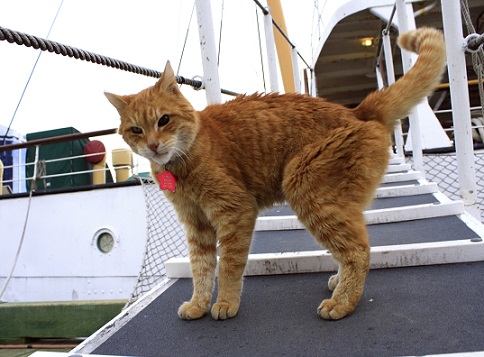
The sentinel of the ship – Photo: Gerry Lunn
On December 7, 2010, RCO Clara passed away ashore in the care of loving company. When I returned to Acadia that evening, Erik and I shared a generous feed of fresh pan-fried haddock and lingered afterward, within the stately confines of the Officer's Mess, for a mug-up and yarn swapping in regard of Clara's glory days. There was no need to discuss sorrowful things, we steered well clear of the Doldrums and, in fact, it went without saying our lives and work would take some adjusting. Erik was granted a field promotion from RCO; Junior to RCO proper - and would thereafter contain his roaming to the Museum and general vicinity. That night, Erik slept in Clara's bunting berth for the first of many times.
As autumn waned in 2011 and through the ensuing winter, Erik ventured ashore from Acadia infrequently, and, if at all, only to spend an afternoon sojourn in the comfort and company of local friends in some proximate office, café or Visitor Information Centre. He spent little time idling about in the cold and this signaled a distinct shift in habit. The wiry lad had always seemed immune to frigid temperatures, if seldom enamoured by snow itself.
By mid-summer 2012, it was but with some degree of difficulty that Erik could achieve the three foot jump from galley counter-top to the Shelter-Deck porthole exit 'door'. It became necessary for me to construct a small interior gangway (or, cat-walk) to bridge the distance.

The nineteenth century advent of iron and steel use in marine construction may have represented the greatest revolution in the history of shipbuilding, but steel bulk-heads have never been known for their insulative qualities. Erik was ever like the fabric of Acadia herself: strong and thin as steel plate, but with just as little insulating fat on his bones. The onset of winter 2012 saw our RCO spending inordinate amounts of time nestled in the make-shift berth of bunting folded atop the Officer's Mess radiator. By January, it was clear he was losing his 'unfazed by the cold' super-power and it was decided to issue the aging salt a leave of absence to extend through the remnants of the winter.
Erik moved ashore to Lynn Bradley's north end home and was duly pampered until the next spring. While he would enjoy two more glorious summers navigating the Museum wharves during this partial retirement phase of his career, his winter shifts were now at an end. As for me, well, perhaps somewhat too selfishly, I seemed more acutely aware that future night watches during the season of gales that follows a December solstice in this harbor town would now be a largely solitary endevour - and more than a tad lonelier for that.
Winter of 2014-15 saw the introduction of a marked difference in Erik's overall health. Diagnosed with hyper-thyroidism in 2008, Erik had reached a point where he required medication twice daily. In spring of 2015, melanoma was discovered in his left eye forcing a difficult choice upon Lynn and me: euthanize our dear lad, or have the offending orb removed. Our choice of the latter option was arrived at through simple deductive logic: Erik had always proven himself proverbially tough as nails so we therefore reasoned the partial, discretionary loss of sight would allow the better part of his valor to be retained. Indeed, the procedure ultimately provided two additional happy years he would not have otherwise enjoyed. It took no more than two hours of post-operative recovery at his doctors' and less than an additional four hours at home for the tenacious tom to be up and about, clawing at the back door for yard access and, generally, behaving as if nothing particularly out of the ordinary had occurred.
But Erik had definitely slowed a step. His remaining days would be defined more by caution than curiosity - a greater sense of temperance than temerity. As befitted the 'Red-mans' ultimate pirate personality, however, the loss of one eye would also yield some light hearted inferences when the Maritime Museum hosted an official retirement party for Erik in September of that year. That day's events were attended by over 800 souls from in and out of town, country and continent, all present to show their respects to our long serving RCO. The promotional materials created for the occasion featured photos of the lad digitally altered to give him a leather eye patch and head-wear featuring the skull and cross-bones.
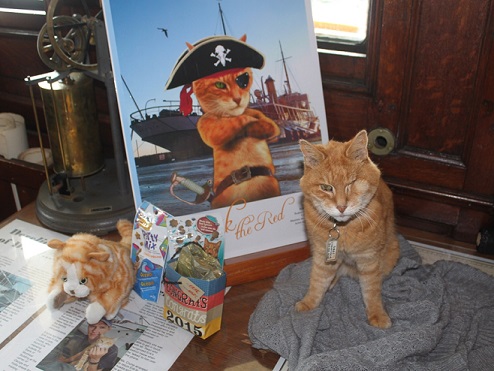
Erik’s retirement party – photo: Steve Read
With the exception of one final cat-napping, which saw him go missing for four days, the bulk of Erik's retirement spent in Halifax's historic north end district was lived in comfort, if not luxury. On two occasions, the retired professional allowed himself to be contracted out on consultations involving field mice in a family residence. But, for the greater part, Erik settled into a routine of eating, exerting his authority over the other four legged (and two legged) creatures in the household, and well deserved rest - punctuated only by occasional outdoor excursions, and visits from old friends.
On the morning of Monday, July 17 this year, Erik was experiencing some difficulty when walking, his gait seeming a bit less steady than the norm. His appetite and overall demeanor remained healthy, however, so that, while our pace might be slowed somewhat, our ability to enjoy neighborhood night walks, late, when cars were sparse, was not yet over.
Through Sunday, July 30 and Monday the 31st, the old fellow's appetite slackened.
Tuesday morning I woke to the sound of Erik mewling and clawing at the back door for yard access. I opened the door and he slowly sauntered off to the garage gaining access through a gap in the side door. The cool shade within the shed was a preferred refuge on hot summer days. The erstwhile tar selected an appropriate spot and laid down. He took a little food and water in the forenoon, but nothing thereafter save for some medication. At about 1500 hours and a quarter, with both Lynn and I at his side, Erik stretched his reposed limbs and took one last yawn.
- - - - - - - - - - - - - - -
That Erik was proficient in his duties as Rodent Control Officer would qualify as one of the major understatements of this short-lived current century. The most experienced pest extermination outfit in the world could never access half the nooks and crannies that make up the maze-like interior structure of a ship. Erik, with his lithe but powerful form and instincts honed from the days of his early street life, was an absolute natural. But the RCO was also tireless in his patrols of Acadia's exterior decks and surrounding wharves - limiting pigeons and sea-birds, as well as their leavings on the ship's decks. He performed his duties with the utmost efficiency, had leave to indulge his explorers heart at any occasion, all while his 'off duty' personality - at once rakish pirate and completely adorable rogue - ensured that legions of friends made would always have a kind word, a chin scratch, a belly rub, a lap to lie in, a food treat or all the time they could spare merely for his company. As I mentioned a way back, and with apologies to Ireland's iconic Reilly, it was the life of Erik.
I never knew Nannie, who was Bert’s predecessor in the roll of RCO. I joined Acadia in 1992 when Bert was in his heyday. Of the three RCOs I have known, worked with, and that I came to love, each and all, Erik was certainly the most prolific in his work and the longest serving in the position. Erik’s time aboard also encompassed a period that saw a reduction in crew and volunteers assigned to or living aboard our Museum Ship. In the years before the end of Erik’s tenure, and, for a stretch following the retirement of Clara in 2010, there were countless night watches aboard, blessed by sweet summer breezes and beset by harsh winter gales alike, wrangling mooring lines in January blizzards and even a hurricane, where my only companion was a major little orange-ish dude, my good buddy, Erik the Red.
The Norsemen of the Middle Ages - one of whom our RCO was famously named for - believed that worthy souls would, in death, be escorted by Valkyries to the great hall of Valhalla in Asgard. I wish you well in your journey old friend. Bravo Zulu, safe passage, fair winds and, if you can use all that skill and cunning of yours, if you can coax or connive an extra place for this one unworthy soul at the table in that great hall, I promise there will always be a piece of fresh haddock on my plate for you.
Stephen Read, Ship-Keeper, CSS Acadia, August 19, 2017
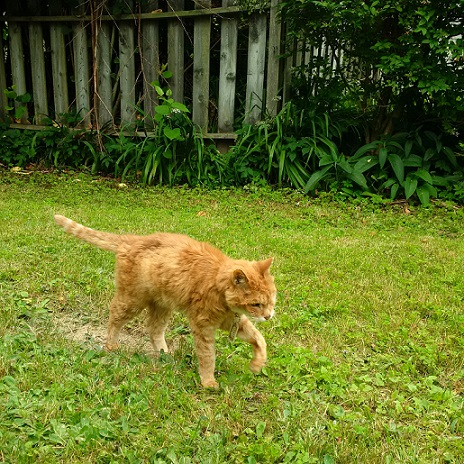
Erik the Red: Well Done, Good and Faithful Servant– photo: Steve Read